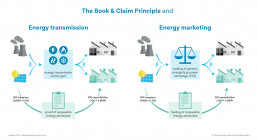Purpose and instrumental scope of guarantees of origin (Fundamentals Report G2)
In the power sector, guarantees of origin (GOs) have become established as a verification instrument for tracking the renewable properties of electricity and allocating them to individual consumers. GOs record key characteristics of the energy unit produced, such as energy source, technology, plant age and plant location. The cancellation of GOs makes it possible to attribute these properties to the energy consumption of a specific consumer. For example, when electricity suppliers cancel GOs for the power consumed by their green electricity customers, the latter are assured that their consumption has been covered by the production of an equivalent amount of electricity from renewable energy sources and that the green attribute of each MWh fed into the grid has been marketed only once. The book & claim principle allows the transfer of GOs to take place independently of the physical transfer of energy. This is particularly relevant in the case of grid-bound supply, when the physical path taken by an energy unit with certain properties through the grid cannot be traced. GOs nevertheless afford consumers the opportunity to express their preference for energy from renewable energy sources by choosing a “green” energy product with a balance-sheet RES share of 100%. In many cases, it is GOs that enable RE plant operators to market the green quality of their energy.
Guarantees of origin and the book & claim principle
The substantially revised Renewable Energy Directive (EU) 2018/2001 (“RED II”) has significantly expanded the scope of GOs. RED I only provided for the issuance of GOs for electricity and optionally for heating or cooling from renewable energy sources. Article 19 of RED II, on the other hand, takes a much broader approach and provides that Member States must ensure that producers of energy from renewable sources receive GOs on request. A distinction is made between GOs for electricity, gas, including hydrogen, and heating or cooling. This extension to additional energy sources necessitates a further development of the GO systems in the EU member states. In this context, it is important to clarify the role that GOs should play in the future in different energy sectors. Interactions with other verification systems for renewable energy must also be taken into account (e.g. mass balancing for gases). The established electricity GOs are also facing new demand resulting from the growth of the green electricity market and structural changes in demand. For example, given their sustainability and climate neutrality strategies, companies are increasingly driving the rising demand for GOs. Through long-term Power Purchase Agreements (PPAs), corporate consumers can secure not only the electricity but also its verifiable renewable origin by means of GOs.
An important aspect of the debate is the question of which purposes GOs should serve. Depending on the intended use, there are different expectations of the instrumental scope of GOs, some of which require further development of GO systems and other energy policy instruments. In particular, the following GO use cases can be distinguished:
- Consumer information.
- Enabling trade in the renewable or "green" characteristics of energy production
- Market-driven support for the expansion of renewable energy.
- Supporting the enforcement of other energy policy instruments (e.g. as evidence for eligibility requirements or regulatory requirements).
- Use for statistical or monitoring purposes.
The Fundamentals Report G2 presents different areas of application and further development perspectives for the use of GOs. The starting points are the GO system in Germany and its national and European legal framework. The use of GOs for consumer information and enabling the trade in renewable properties constitutes the status quo in Germany, while other use cases necessitate a further development of the role of GOs. In this context, the scope of GOs is discussed, complemented by examples of interactions with the instrument mix for the energy transition. Finally, an outlook is given on both synergies and potential conflicts that need to be considered prior to expanding the use cases.



